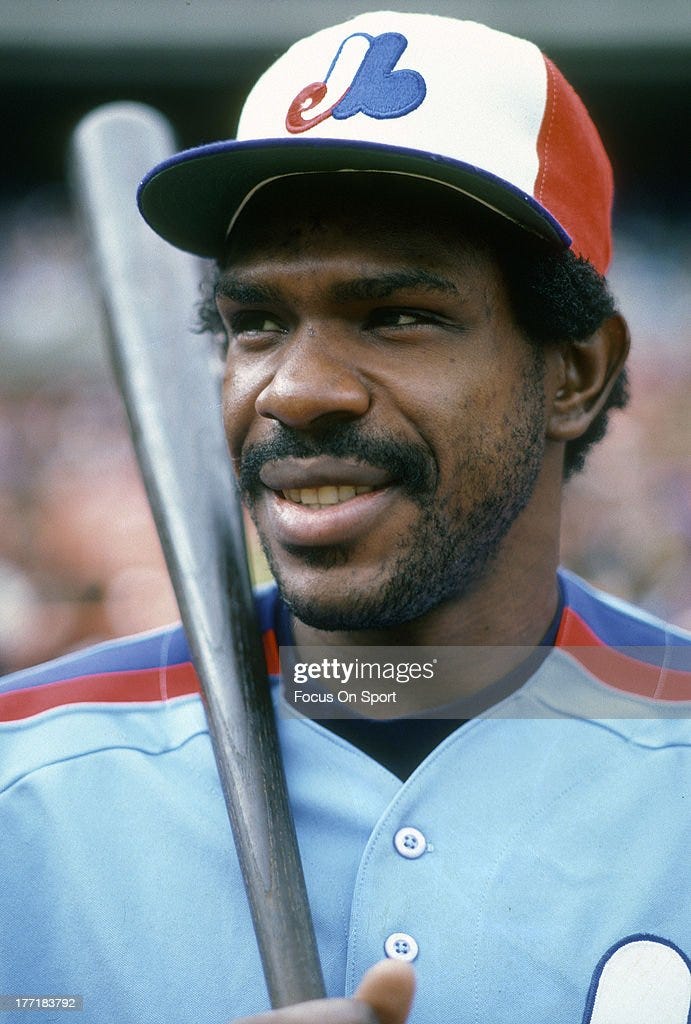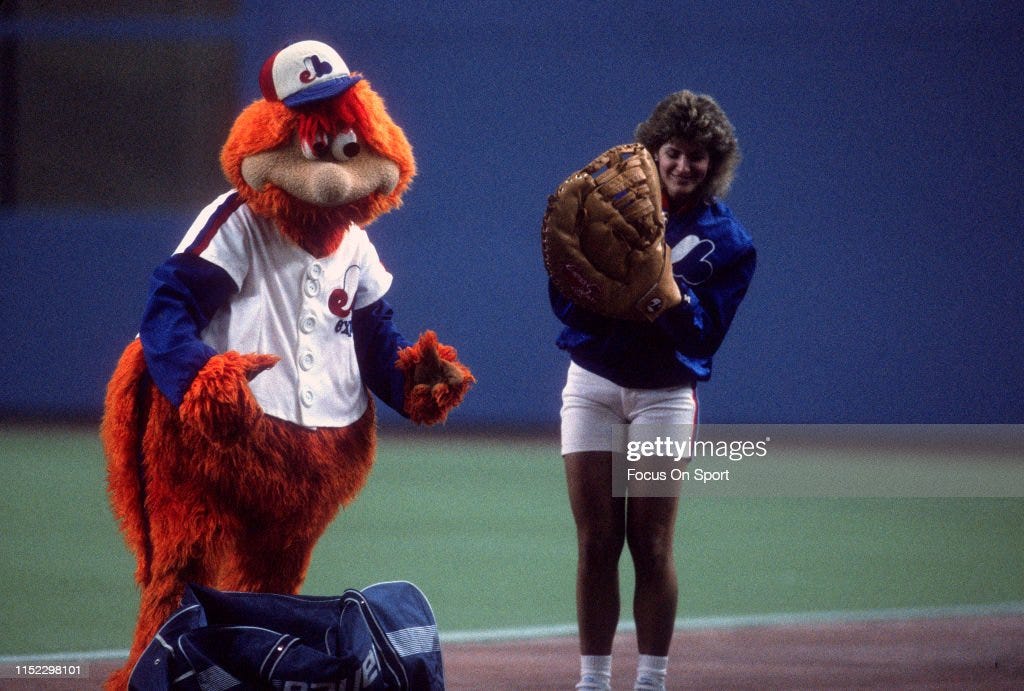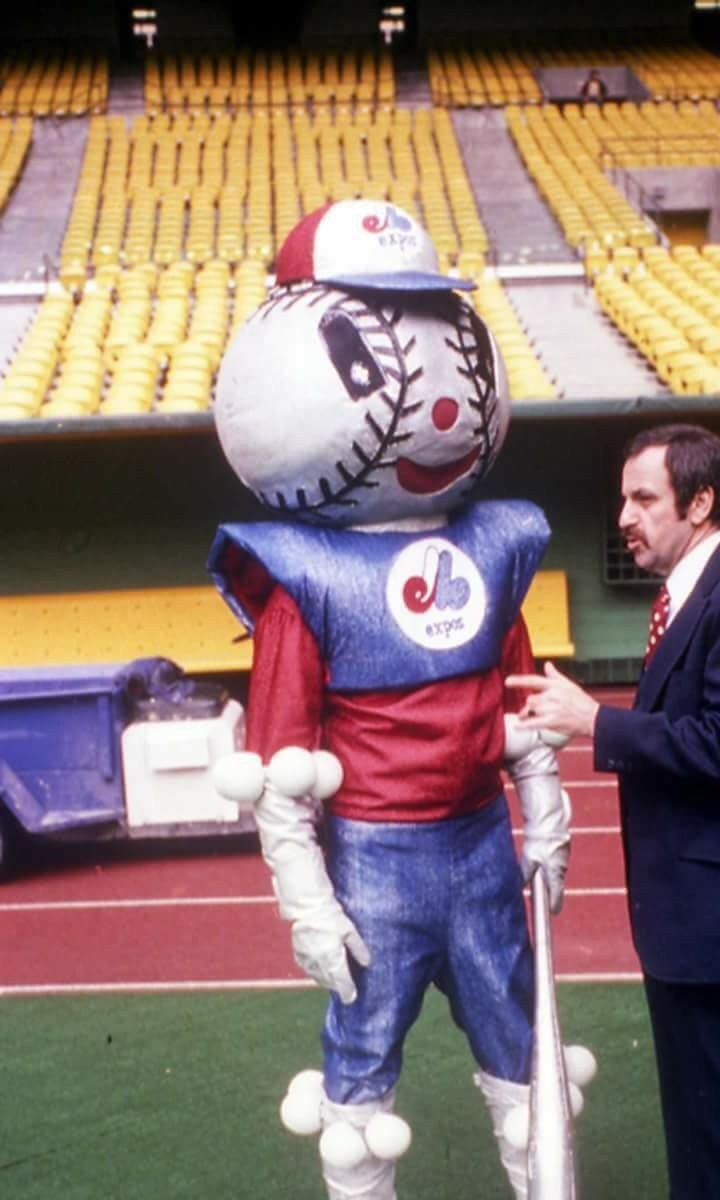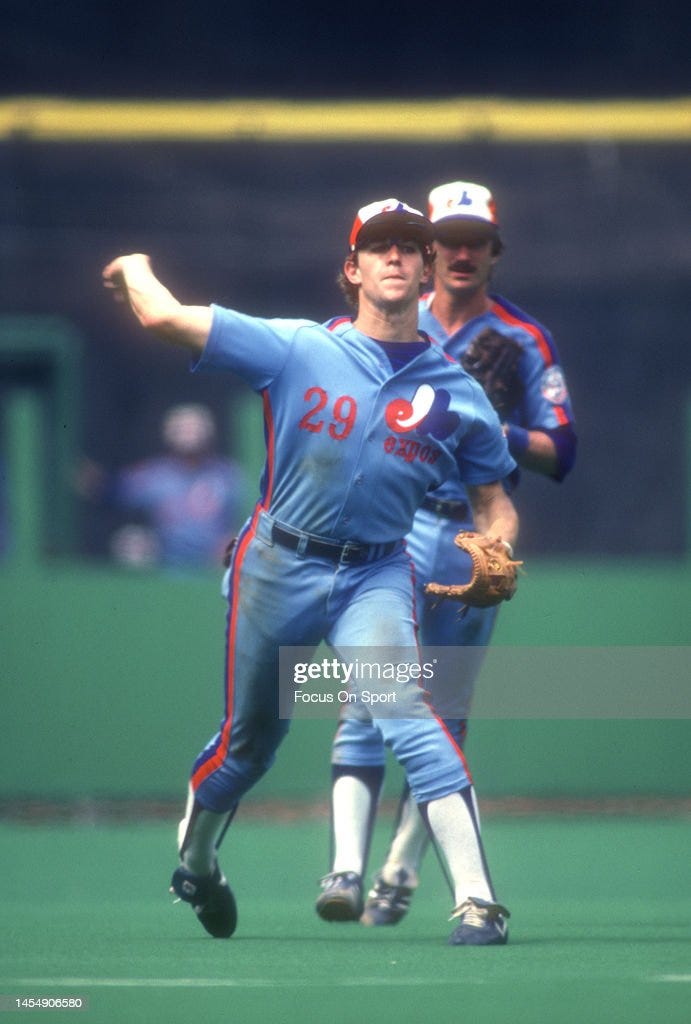
A few years ago, I went online and bought myself a Montreal Expos hat. I’m not in the habit of making spur of the moment purchases, and I don’t think of myself as a terribly materialistic person. But I’d be lying if I said this particular item didn’t fill me with the same kind of excitement and anticipation usually reserved for a kid on Christmas morning.
I have a soft spot for sports franchises that no longer exist. I suppose they appeal to my interest in history. If you can’t tell by the very existence of this blog, the whole sports and history and nostalgia intersection is a spot where I feel very at home. Hey, gotta put that history degree to use somehow.
I own a faded Houston Oilers Velcro wallet given to me when I was a kid. No, I don’t still use it, but it is safely tucked away in a box of keepsakes that possess only sentimental value to me. One of my more modest goals in life is to someday buy a throwback Kansas City Kings jersey, which would go well with my Kansas City Athletics hat.
But my pride and joy is the Expos hat. It’s a beauty. Regardless of what other mistakes the Expos franchise made during its existence, and they made plenty, no one can fault their graphic design department.
Mine is the real deal too, the original red (back), white (front), and blue (bill) design— not the lame all blue variation they switched to in the 90’s. The same three colors come together to form the logo that adorns the front of the hat, one of the most instantly recognizable in baseball history.
The swooping design forms an M at an obvious first glance, but a closer look reveals that each half of the M is made up of a lowercase e and b, which together stand for Montreal Expos Baseball. There’s a slight tilt to it as well, symbolizing the forward movement of the franchise. Well, maybe they did miss the boat on that last part.
Supposedly, not a lot of people responded positively when the logo was first introduced. I don’t know what their problem was. I loved that logo from the first time I saw it when I was six years old, and I still love it today. In my opinion, no other image in baseball has ever come close to matching it, with the possible exception of the Brewers’ ball-in-glove logo.
I’m wearing the hat in a picture that hangs on our living room wall. The shot was taken by a friendly passing rando during a trip to Kauffman Stadium in 2015. The Royals were on their way to a world championship, and I was making an effort to get out to the park as often as I could that summer. So I threw on my Expos hat and suggested to my wife that we catch them play the White Sox on an otherwise uneventful Sunday afternoon.
She wasn’t my wife at the time. In fact, we’d only been dating a few months, and this was one of our first big event dates. We bought tickets at the gate, and settled for nosebleed seats that were a pain to actually reach. Keep in mind that the Royals were one of the best teams in baseball that season, and empty seats were at a premium.
Tired of crawling over people to hit the concession stands or restrooms, we decided to abandon the upper deck in the fifth inning. We walked around to the other side of the stadium and found a spot to stand overlooking the fountains. That’s how we took in the rest of the game, at some point handing over my phone to a stranger to capture the moment.
Naturally photogenic and in her prime, my wife is smoking hot in the pic, wearing shades and holding a drink in her hand. I was already past my prime at that point, but I’m presentable enough with my arm around her shoulder. The Expos hat undoubtedly helps me out quite a bit.
A year or two later, as we were preparing for another trip to the park, my son asked if he could wear the Expos hat. I told him I wasn’t sure if he was ready for that, and he shot me a puzzled look.
“People love that hat,” I explained, though he still seemed a bit skeptical. “If you wear it, I guarantee someone will go out of their way to compliment you on it,” I said. “And if no one does, I’ll buy you a new hat of your choice from the gift shop.”
He took the challenge, naively confident that he would be leaving the K with some new headgear. We had barely stepped inside the front gates, however, when someone called out to him. “That’s a great hat!” the guy told him, flashing an enthusiastic thumbs up. Several more endorsements followed throughout the game, and he went home still wearing it. There would be no new hat that day.
So yeah, I have a lot of good memories associated with that hat. It’s just too bad that the actual history of the Expos franchise is a glowing paean to disappointment. So much about the Expos was endearing and eminently likable, and yet it never seemed to come together.
Superstition and baseball go hand in hand. The word curse is liberally tossed around in the sport. The Red Sox went eighty-six years without a title because of the Curse of the Bambino. The Billy Goat Curse tormented the Cubs for over a century. The White Sox also suffered for eighty-six years due to the Curse of the Black Sox.
I don’t know of any formal curse ever laid down upon the Expos, but few professional sports franchises have ever felt as snake-bitten. Among other things, the team’s unofficial historian is a glaring example of how the Expos can’t seem to stay out of their own way, even years after the team’s demise, endangering the enduring legacy of one of baseball’s most unusual franchises.
Jonah Keri was one of baseball’s most respected writers. He had a weekly podcast on Grantland (the ESPN offshoot), back when that was still a thing, with a ridiculous and catchy theme song and a revolving door of A-list guests. He was funny and charming and likable, and I was a regular listener.
Naturally, I was thrilled when he announced that he was writing a history of the Expos. I love those kinds of books, and immediately added it to my to-read list. But before I could get to it, Keri was arrested for assaulting his wife and infant child. Turns out, he’s a terrible human being, and he’s currently in prison.
The book is still available, and I admit I’m torn. He might be a monster, but that doesn’t necessarily diminish the quality of the book. Lots of writers are terrible people, and I really want to learn more about the Expos. But I can’t bring myself to pick it up. The whole thing is tainted now.
Fortunately, there are other resources out there you can use if you want to learn more about the Expos. And I do want to learn about the Expos. The list of ballplayers who spent at least a portion of their careers in Montreal can hold its own with any other organization in baseball.
Andre Dawson. Tim Raines. Gary Carter. Larry Walker. Randy Johnson. Pedro Martinez. Vladimir Guerrero. All of these Hall of Famers passed through Montreal. Some used it as a brief stepping stone to greater success. Others are integral to Expos history.
Tim Raines and Andre Dawson are probably the two most iconic players to ever wear the striking powder blue Expos road uniforms. (The vibrant white home jerseys with the Expos logo on the chest were quite eye-popping as well.) They achieved tremendous success in Quebec, but their bittersweet exits are indicative of how the Expos operated.
Dawson was inducted into Cooperstown as an Expo, but only because he wasn’t given any choice in the matter. The Hawk played for Montreal from 1976-86, and he owned practically every team offensive record by the time he and the Expos parted ways. And he did it all while playing for a bargain basement salary.
Here’s the deal. The Expos were cheap. Part of their thriftiness was by choice, and part of it was because they were an extremely poorly run organization. From the day they opened for business in 1969 to when they moved to Washington to become the Nationals in 2004, they had several different ownership groups. And none of them ever seemed to know what the hell they were doing.
They played in Olympic Stadium, which was a dump even when it was new. The turf on the field wreaked havoc on players’ bodies. The weather in Canada was always causing issues, especially early in the spring, until a retractable roof was installed in 1987. Even then, it regularly malfunctioned. A fifty-ton beam fell from it in September 1991, forcing the Expos to play the last month of the season entirely on the road due to safety concerns.
None of this did the club any favors as it tried to win over and draw a somewhat reluctant French-Canadian fanbase to the game. Sure, they had cool uniforms and two incredibly unique mascots, but it would take more than that to convert Quebecers.
The first mascot, Souki, was a terrifying man/baseball hybrid from the future who you have to see to fully appreciate. He was quickly retired and replaced by Youppi, a much friendlier-looking muppet in the mold of the Phillie Phanatic. Youppi proved to be quite popular, earning the distinction of being the first MLB mascot ever ejected from a ballgame during a 1981 matchup with the Dodgers. (Tommy Lasorda was not a fan.) In fact, Youppi outlived the Expos and currently represents the Montreal Canadiens of the NHL.

But like I said, uniforms and mascots only move the needle so much. Good players and wins on the field are what make a franchise go. The Expos never seemed to have a shortage of outstanding players, but holding onto them was something they couldn’t master. At times, it felt like they didn’t even try.
Looking back, the Expos sort of remind me of the Florida Marlins, before the Marlins even existed. Florida won the World Series in 1997 and 2003, and in both instances, immediately followed their championships with fire sales, trading off every valuable player to save money. The Expos did a lot of that too, only they never bothered to win any championships first.
The Expos only made one postseason appearance in their history, and even that was largely due to the strike in 1981, which interrupted the season and created extra playoff spots. To their credit, the Expos knocked off the defending champion Phillies in the LDS, but lost to the Dodgers in the NLCS, one game away from the World Series, when Rick Monday hit a home run that would go down in Expo lore as “Blue Monday.”
That brings us back to Dawson. Two years before he hit free agency, the Expos traded another future Hall of Famer, catcher Gary Carter, to the Mets, where he would go on to win the 1986 World Series. Even so, they still had a strong nucleus of talent, headlined by Tim Raines, Tim Wallach, and Denny Martinez. Retaining Hawk would only make them that much stronger. But they had no intention of paying him.
They didn’t want anyone else to pay him either, so they colluded with other owners to keep his price tag down and started a whisper campaign to spread the rumor that his knees were shot in order to scare other teams off.
Dawson caught wind of it and walked into spring training with the Chicago Cubs, handing them a signed blank contract. Ultimately, he took a fifty percent pay cut to sign with the Cubs, just to spite Montreal, and went on to have the best season of his career. Dawson led the league in home runs and was named the NL MVP.
To baseball fans a few years older than me, Dawson is Mr. Expo. But I’ve always thought of him first and foremost as a Cub. If there’s an Expos version of Batman, to me it’s Tim Raines. And 3B Tim Wallach was his Robin. Those are the first two players I think of when I reminisce about the Expos.
Wallach was the definition of a solid ballplayer. An excellent defender, Bill James called him a poor man’s Brooks Robinson. It’s a backhanded compliment, but it’s accurate and shouldn’t be taken as a slight. A five time All-Star, Wallach was the Expos’ career leader in hits, doubles, RBIs, total bases, and games played.
Wallach was the solid, if unspectacular bedrock of the Expos. Tim Raines was the flash. If you can’t tell by my gushing in previous posts over players like Willie Wilson and Rickey Henderson, Raines fits the mold of my favorite type of player— a skilled hitter capable of producing some pop, lightning quick on the basepaths, and able to flash his talent with the glove.
Another future Hall of Famer and a seven-time All-Star (1981-87), Raines finished second in the NL Rookie of the Year vote in 1981 to Fernando Valenzuela, a feat he accomplished while ingesting enough cocaine to single-handedly support his own personal cartel. Raines famously adopted a head-first slide when stealing bases so he wouldn’t damage the coke he kept stashed in his back pocket at all times, even during games.
Not surprisingly, this habit began to take its toll during the 1982 season, and he wisely decided to go to rehab and get clean in the offseason. Fortunately, this worked, and other than the embarrassment of getting swept up in the publicity of the Pittsburgh Drug Trials a few years later, Raines was able to successfully get his career back on track.
And what a career it was. Take a quick look at his stats:
The 808 steals rank fourth or fifth on the all-time list, depending on how you view Billy Hamilton’s stats. Hamilton played in the 1800’s when they had a different definition of stolen bases. Any time a player grabbed an extra base on a hit— for example, when they went first to third on a single— that counted as a steal. To me, that’s just smart baserunning, not a stolen base. So I rank Raines fourth.
Raines was named the Expos player of the year in 1983, ‘85, and ‘86, but this didn’t inspire the club to treat him any better than Dawson. They colluded against him prior to 1986, and he eventually caved and re-signed with Montreal. He even had arguably the best year of his career, despite missing over a month to start the season in a contract dispute.
1986 Stats: .334/.413/.476, 9 HR, 62 RBI, 35 Doubles, 10 Triples, 70 SB, .889 OPS, 145 OPS+

The writing was on the wall, however, and it was only a matter of time before he would be shipped out of Montreal as well. He had a good run with the White Sox in the early 90s, and eventually got a couple of championships with the Yankees.
The Expos, meanwhile, rebuilt, and put together an even more talented core featuring players like Marquis Grissom, Delino Deshields, Moises Alou, and Larry Walker. In 1994, the Expos were having the best season in franchise history. At 74-40, they were firmly in control of the new NL East, six games up on the mighty Atlanta Braves.
Then the Strike shut it all down. No pennant race. No playoffs. No World Series. It was just over. Effectively, it was the death blow to baseball in Montreal. When the strike was finally settled the following spring, Expos management— cash starved and deprived of their long-awaited postseason payday the previous fall— proceeded to sell off every player with a pulse.
The fans had seen enough. Rooting for the Expos had never been particularly rewarding, but it no longer seemed to have any point at all. Baseball in Montreal staggered on for another decade, but few in the city seemed to notice.
New stars would come and go. Most were shipped out the second they were in position to demand a pay raise. A few, like Vladimir Guerrero developed into bona fide superstars, but none of this later generation were ever embraced by Montreal like Dawson, Carter, or Raines.
A few years before the Montreal operation closed its doors for good and moved to Washington, they re-signed Tim Raines in 2001. Raines was well past his prime and many saw it as a gimmick move to sell a few more tickets. They were probably right, but when he took the field during the Expos’ home opener, he was greeted by a moving standing ovation from the fans.
This was arguably baseball’s last hurrah in Montreal. Raines performed well in a part-time role for the Expos, but it was like the front office couldn’t help themselves. They traded him to Baltimore before the year was over.
Three years later, the Expos were gone altogether, relegated to the corridors of baseball nostalgia. Every now and then, someone floats the idea of bringing baseball back to Montreal. A new expansion team, or maybe the Rays could split their time between Tampa and Canada. At this point, it all feels like a pipe dream.
But hey, at least we’ll always have those cool hats.
Thank you for reading Powder Blue Nostalgia. Do you remember the Expos? What do you miss the most about baseball in Montreal? Let us know in the comments and share with all your baseball fan friends, even if they’re French!






Cool trip down memory lane, Patrick! And, this from a guy who was a fan of the Colt .45s, and was 7 when he saw his first game at Colt Stadium (now remembered with a home plate-sized plaque where home used to be at its original now-Dome-parking-lot site)!
I'm currently wearing (it's a freezing Panera Bread dining room!) a vintage Houston Oilers NFL Quarterback Club/Warren Moon jacket from the late '80s! The inside pocket has Moon's replica signature stitched on it! I tell people it took Warren 2 hours to sit there and stitch it in there!!!😁
One Expos story from my youth: In '69 (I was 14), my family travelled from our Houston home to L.A. for a week. At an Angels game, the giveaway was a Strat-o-Matic computer-card and dice game! My bro, Dad and I couldn't be torn from that game for years!
We'd try to keep the teams as realistically represented as possible, but for some reason, we saw fit to implement "the rape of the Montreal Expos" (seriously, that's what we called it!) sometime in the early '70s....I guess we felt it necessary to spread the team members around to the other teams...thru trades, and maybe, using Monopoly $$, buying free agents)!🤣Great fun, overall, and it brought me, my bro, and Dad together like nothing else did!!
A quizz question for all you hard core Spo's fans. The Spo's had a second baseman for a couple of years, that Rock named him the fastest "white" guy he had ever seen. Can you name him??